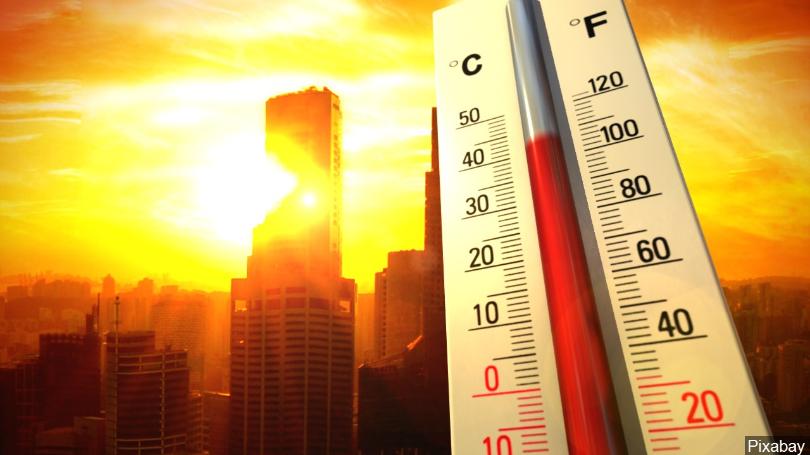I’m going to highlight a new study that reveals that extreme heat levels that are beyond the ability of the human body to cope with are starting to emerge. I’m specifically talking about heat that is beyond the physiological limits of human survival.
Before we get into it, I first need to clearly define a very specific term – wet-bulb temperature.
What exactly is wet-bulb temperature?
I’ve written about this before.
If you wrap a thermometer with a water soaked cloth and then let the atmospheric air pass over it, you are getting a cooling effect via the evaporation of the water. The hot air might be 46C, but the evaporation from the wet cloth will cool the temperature and so the actual reading will not be 46C, but rather a lot less.
How much less?
Well, that depends upon the humidity of the air. The more humid it is the less evaporation can cool things. If for example the air at 35C was at 100% humidity, then evaporation can’t take place because the air can’t absorb any more moisture. Net effect, the wet-bulb temperature would in that case be the same as the atmospheric temperature … 35C.
In drier hot air you don’t just feel cooler, you are actually cooler. The evaporation enabled by the drier air enables you to stay a lot cooler.
The Human physiological limit is a Wet Bulb Temperature of 35C
Your core body temperature is 37C and so you skin maintains a temperature of 35C (or below) so that the core temperature can be maintained. If the wet-bulb temperature rises above 35C then no matter how much you sweat, it will not cool you below that critical 35C. Unless you gain access to air conditioning then you will overheat. The word used to describe that is Hyperthermia – the opposite of hypothermia (too cold). It is perhaps more common to call hyperthermia heat stroke.
Today the wet-bulb temperature generally never exceeds 30 or 31C, but in a warming world we are fast approaching a time when we will hit and then pass that 35C limit.
Not even the fittest of humans can survive, even in well-ventilated shaded conditions, when the wet-bulb temperature stays above 35C.
New Study: The emergence of heat and humidity too severe for human tolerance
Published within Science Advances on 8th May 2020, the paper describes how a comprehensive evaluation of weather station data shows that some coastal subtropical locations have already reported a Wet Bulb Temperature of 35°C and that extreme humid heat overall has more than doubled in frequency since 1979.
Climate models had estimated that the first 35°C Wet Bulb Temperatures would occur by the mid-21st century, but this new paper reveals that such extremes have already arrived.
What exactly did the researchers do?
They conducted a survey of weather station data from 1979-2017.
This identified over 7,000 past occurrences of wet-bulb temperatures above 31°C and over 250 above 33°C around the world, as well as two stations that reported multiple daily-maximum wet-bulb temperatures above 35C.
These extremes occurred for 1-2 hours in parts of coastal southwest North America, including southeastern California and southwestern Arizona, South Asia, and the coastal Middle East.
As wet bulb temperatures approach 35C, even the healthiest people, relaxing in the shade without heavy clothing and with an endless supply of water, cannot prevent themselves from overheating.
Though the reported extreme instances were brief and highly localized, a large number of locations, such as near the Persian Gulf and Red Sea, could surpass the 35°C threshold in just a few decades, much sooner than other studies have suggested, according to the authors. Many populous areas are close to the limit.
Too Hot and Humid
The map below map shows locations that experienced extreme heat and humidity levels briefly (the hottest 0.1% of daily maximum wet bulb temperatures) from 1979-2017. Darker colors show more severe combinations of heat and humidity.
Some areas have already experienced conditions at or near humans’ survivability limit of 35°C. The Map was created by NOAA Climate.gov, and is based on data from Radley Horton, one of the authors of the new paper.
They have an Interactive Map.
An interactive map created by the researchers plots the highest wet-bulb temperatures recorded at stations across the world.
Study Author Comments
Radley Horton, a Columbia University professor and lead of NOAA’s Urban Northeast RISA team who co-authored the study …
“I believe that humid heat is the most underestimated direct, local risk of climate change, As with sea level rise and coastal flooding, we are already locked into large increases in the frequency and intensity of extreme humid heat events, and the risk is much larger than most people appreciate.”
Colin Raymond, the study’s lead author who conducted work at Columbia University and is now a postdoctoral scientist at NASA’s Jet Propulsion Laboratory …
“When wet-bulb temperatures are extremely high, there is so much moisture in the air that sweating becomes ineffective at removing the body’s excess heat, like what happens in a steam room, At some point, perhaps after six or more hours, this will lead to organ failure and death in the absence of access to artificial cooling.”
Further Reading
- Science Advances (8th May 2020): The emergence of heat and humidity too severe for human tolerance
- NOAA Research News (9th May 2020) – Dangerous humid heat extremes occurring decades before expected
